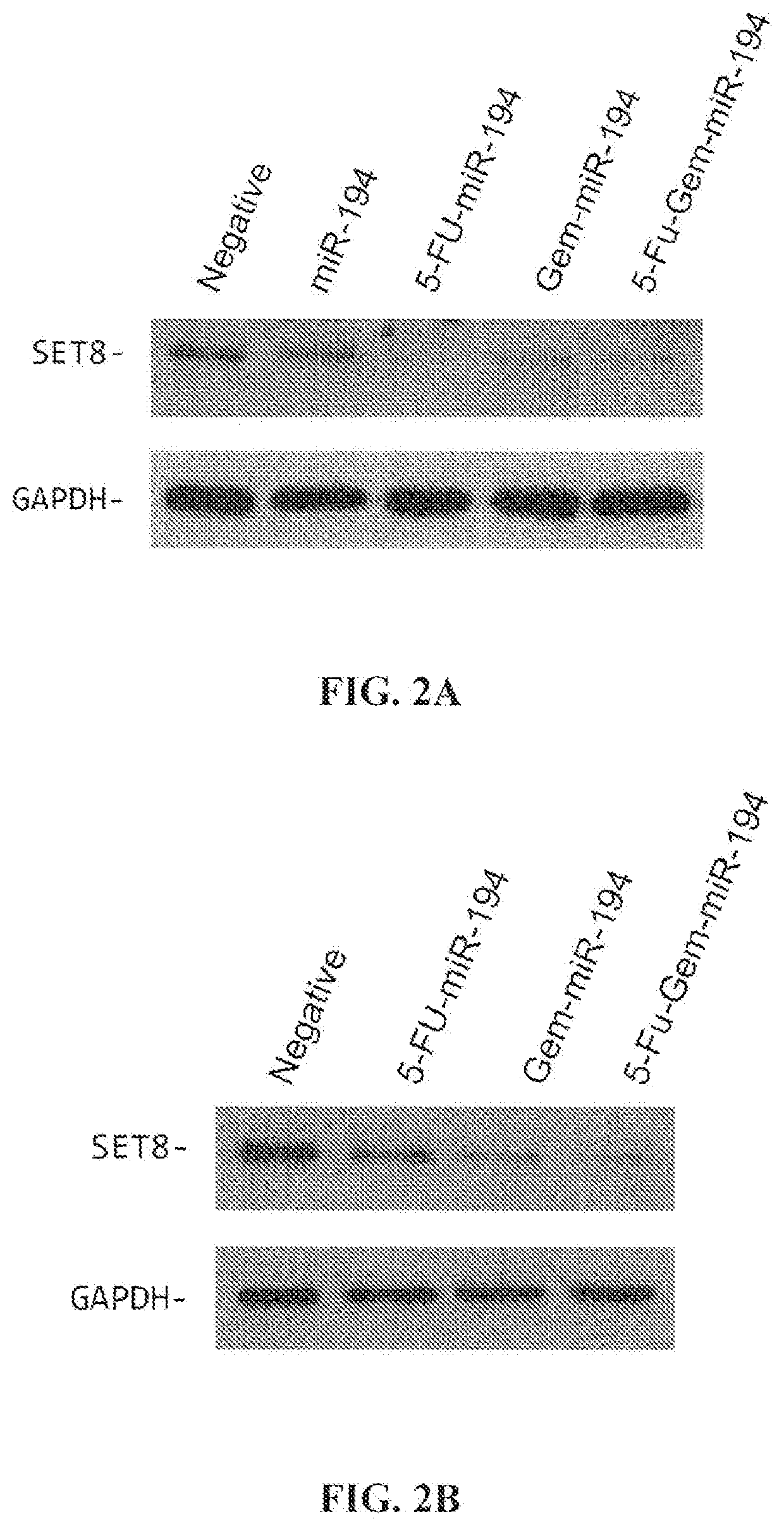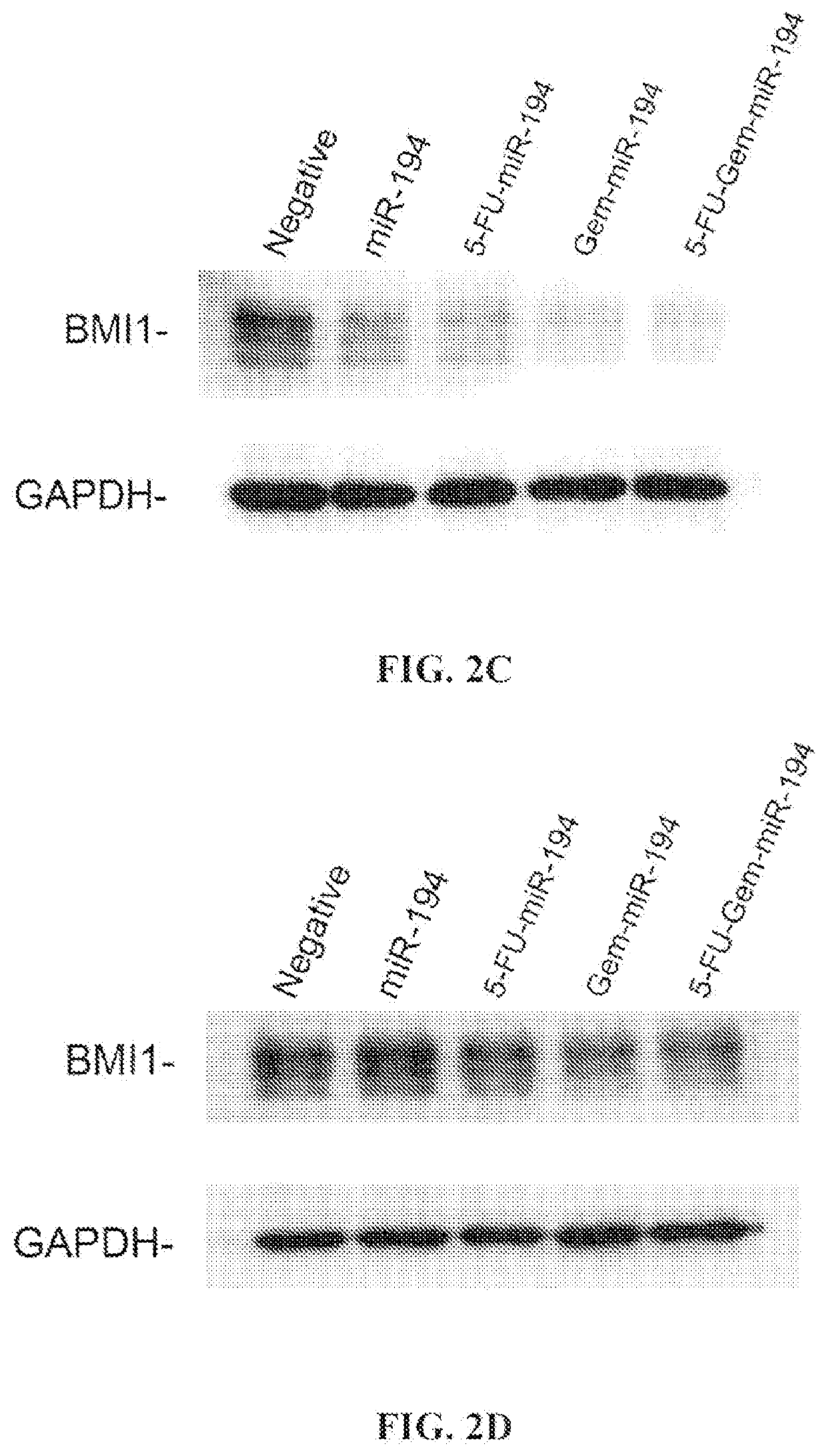Modified micrornas and their use in the treatment of cancer
a technology of micrornas and cancer, which is applied in the direction of genetic material ingredients, viruses/bacteriophages, drug compositions, etc., can solve the problems of limited therapeutic intervention effect, unfavorable treatment effect, and high toxicity of 5-fu and gemcitabine, so as to improve the efficacy of micrornas as anti-cancer agents, reduce tumorigenesis, and improve the effect of microrna efficacy
- Summary
- Abstract
- Description
- Claims
- Application Information
AI Technical Summary
Benefits of technology
Problems solved by technology
Method used
Image
Examples
example 1
and Methods
[0111]Modified microRNAs. All modified microRNAs were synthesized by an automated oligonucleotide synthesis process and purified by HPLC. The two strands were annealed to make the mature modified 5-FU-miRs and / or modified miR-194 having cytosine bases replaced by a gemcitabine molecule of the present disclosure. For modified microRNA 194 containing a 5 halouracil, a process referred to as “2′-ACE RNA synthesis” was used. The 2′-ACE RNA synthesis is based on a protecting group scheme in which a silylether is employed to protect the 5′-hydroxyl group in combination with an acid-labile orthoester protecting group on the 2′-hydroxy (2′-ACE). This combination of protecting groups is then used with standard phosphoramidite solid-phase synthesis technology. See, for example, S. A. Scaringe, F. E. Wincott, and M. H. Caruthers, J. Am. Chem. Soc., 120 (45), 11820-11821 (1998); International PCT Application WO / 1996 / 041809; M. D. Matteucci, M. H. Caruthers, J. Am. Chem. Soc., 103, 31...
example 2
miR-194 Nucleic Acids have Anti-Cancer Activity
[0119]In the following experiments, all 5 cytosine bases in the guide strand of native miR-194 (SEQ ID NO:1) were replaced by gemcitabine to form the exemplary modified microRNA set forth in SEQ ID NO:2. See FIG. 1C. Another modified microRNA was formed by replacing all uracil bases in the guide strand of the native miR-194 nucleic acid with a 5-FU molecule, as set forth in SEQ ID NO. 4. See FIG. 1B. In one experiment, all U bases in miR-194 were replaced with 5-FU and all cytosine (C bases) were replaced by a gemcitabine molecule, as shown in the structure provided in FIG. 1D and as set forth in SEQ ID NO: 3.
[0120]Analysis of target specificity: The results of Western immunoblot experiments in pancreatic cells demonstrate that the exemplary modified miR-194 polynucleotides of the present disclosure were able to retain their target specificity to SET8 and BMI1. The results are shown in FIGS. 2A through 2D, which shows the results for th...
PUM
| Property | Measurement | Unit |
|---|---|---|
| Composition | aaaaa | aaaaa |
Abstract
Description
Claims
Application Information
 Login to View More
Login to View More - R&D
- Intellectual Property
- Life Sciences
- Materials
- Tech Scout
- Unparalleled Data Quality
- Higher Quality Content
- 60% Fewer Hallucinations
Browse by: Latest US Patents, China's latest patents, Technical Efficacy Thesaurus, Application Domain, Technology Topic, Popular Technical Reports.
© 2025 PatSnap. All rights reserved.Legal|Privacy policy|Modern Slavery Act Transparency Statement|Sitemap|About US| Contact US: help@patsnap.com



